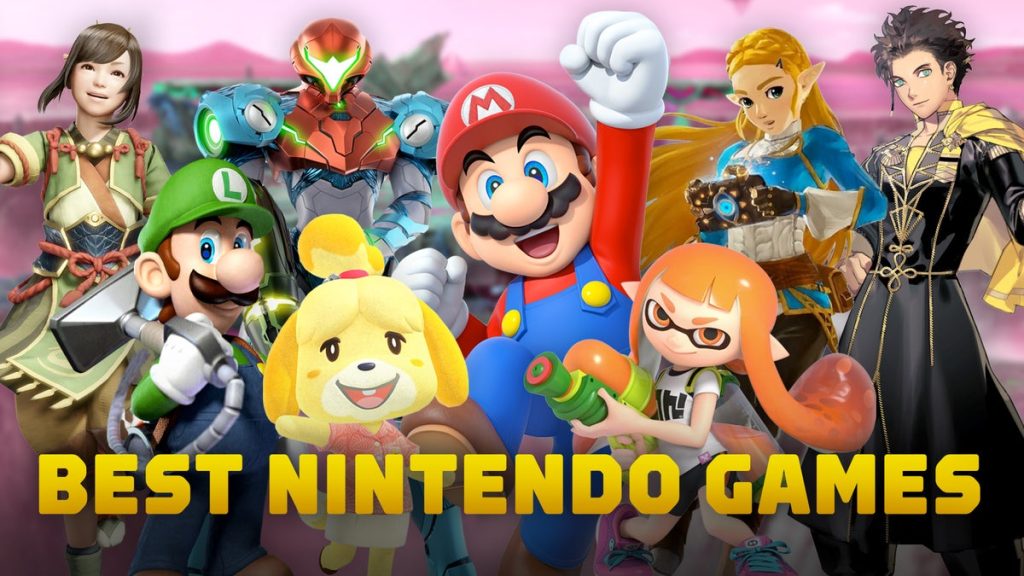
Nintendo, a name synonymous with gaming, has been at the forefront of the video game industry for decades. Since its founding in 1889 as a playing card company, Nintendo has undergone a remarkable evolution, becoming one of the most influential and beloved gaming companies in the world. Known for its iconic franchises, innovative hardware, and commitment to fun and accessible gameplay, Nintendo has created countless memories for players of all ages. This exploration will delve into the world of Nintendo games, examining their history, innovative spirit, and the cultural impact they have had on the gaming industry and beyond.

A Brief History of Nintendo’s Rise in the Gaming World
While Nintendo’s early history revolved around producing traditional playing cards, the company took a monumental turn in the late 1970s when it ventured into the emerging video game industry. With arcade hits like Donkey Kong in 1981, which introduced the world to the legendary character Mario, Nintendo set the stage for what would become a revolutionary gaming empire. But it was in 1983, with the release of the Nintendo Entertainment System (NES), that the company truly transformed gaming.
The NES, accompanied by iconic titles such as Super Mario Bros., The Legend of Zelda, and Metroid, revitalized the video game industry following the crash of 1983. These games not only introduced innovative gameplay mechanics but also laid the groundwork for the rich narratives, vibrant characters, and captivating worlds that Nintendo would become known for. As gaming moved into the home, Nintendo solidified itself as a household name, defining an era of gaming that would leave an indelible mark on popular culture.
Nintendo’s Game Design Philosophy: Fun for Everyone
Nintendo’s approach to game design sets it apart from many of its competitors. While some gaming companies prioritize cutting-edge graphics or complex storytelling, Nintendo has always focused on delivering fun, accessible, and family-friendly gameplay experiences. This philosophy is evident in many of its flagship franchises, which prioritize creative mechanics, colorful visuals, and universal appeal.
One of the key aspects of Nintendo’s design philosophy is its emphasis on “playability.” Nintendo games are known for their simple yet deep mechanics, offering something for both casual and hardcore players. Take Super Mario Bros., for example. The game’s controls are easy to understand—players can run, jump, and move left or right—but mastering the game requires precision, timing, and strategic thinking. This balance between simplicity and depth has been a hallmark of Nintendo games, making them accessible to newcomers while providing long-term enjoyment for seasoned players.
Nintendo also places a strong emphasis on multiplayer experiences, encouraging players to connect and compete with friends and family. This is seen in games like Mario Kart, Super Smash Bros., and Animal Crossing, which allow players to share in the joy of competition or collaboration, fostering social interactions both locally and online.
The Evolution of Iconic Nintendo Franchises
Over the years, Nintendo has introduced some of the most iconic franchises in gaming history. From the platforming adventures of Mario to the sprawling fantasy realms of The Legend of Zelda, Nintendo’s franchises have become cultural touchstones. Each of these series has evolved over time, adapting to new technology while maintaining the core elements that made them beloved in the first place.
Super Mario Series
Mario, the mustachioed plumber, is undoubtedly Nintendo’s most recognizable character. Since his debut in Donkey Kong and later in Super Mario Bros. in 1985, Mario has become the face of Nintendo. The Super Mario series has consistently innovated within the platforming genre, introducing mechanics such as power-ups, warp zones, and non-linear levels.
As the series progressed, Nintendo expanded the Mario franchise into 3D with Super Mario 64 on the Nintendo 64, which revolutionized 3D gaming and set the standard for 3D platformers. Subsequent titles like Super Mario Galaxy, Super Mario Odyssey, and New Super Mario Bros. have continued to evolve the series, each introducing new gameplay twists while retaining the charm and accessibility that fans love.
The Legend of Zelda Series
First released in 1986, The Legend of Zelda introduced players to the fantasy world of Hyrule and the hero Link, who must rescue Princess Zelda and defeat the evil Ganon. The Zelda series has always been known for its intricate puzzles, open exploration, and epic storytelling. Each game in the series presents a new take on these core elements, from the groundbreaking 3D world of Ocarina of Time to the open-world exploration of Breath of the Wild.
Breath of the Wild, released for the Nintendo Switch in 2017, was a landmark title that redefined open-world gaming. It gave players unprecedented freedom to explore and interact with the world, pushing the boundaries of what a Zelda game could be while maintaining the series’ spirit of adventure and discovery.
Pokémon Series
While not directly developed by Nintendo (the main games are created by Game Freak), the Pokémon series is closely associated with the company and has been a major part of its success. Starting with Pokémon Red and Blue on the Game Boy in 1996, the series has become a global phenomenon, with the goal of capturing and training creatures known as Pokémon. The games blend exploration, strategy, and social interaction, with players trading and battling their Pokémon both locally and online.
With each new generation, Pokémon has introduced new creatures, regions, and gameplay mechanics, such as Mega Evolutions, Dynamaxing, and open-world environments in Pokémon Sword and Shield. The franchise’s appeal lies in its blend of simplicity and depth, allowing players to approach it as a casual adventure or a competitive challenge.
Other Major Franchises
Nintendo has also been responsible for other iconic franchises such as Metroid, Fire Emblem, Animal Crossing, and Splatoon. Each of these series has its own distinct style and gameplay mechanics, contributing to the wide variety of experiences Nintendo offers its players. Metroid pioneered atmospheric exploration in the “Metroidvania” genre, while Animal Crossing provides a peaceful, life-simulation experience that emphasizes creativity and community.
Innovative Hardware and Gameplay Experiences
Nintendo is not only known for its games but also for its innovative approach to hardware. Over the years, Nintendo has consistently pushed the boundaries of what gaming consoles can do, often prioritizing unique gameplay experiences over raw technical power.
The release of the Nintendo Wii in 2006 was a major turning point for the company. With its motion-sensing controls, the Wii opened gaming up to a broader audience, allowing people of all ages to enjoy intuitive, physically interactive games. Titles like Wii Sports became cultural phenomena, showing how innovative hardware could create new ways to play.
The Nintendo Switch, released in 2017, is another example of Nintendo’s forward-thinking approach to hardware. As a hybrid console, the Switch can be played both as a traditional home console and as a portable device, offering players unprecedented flexibility in how they engage with their games. The console’s success has been bolstered by a stellar library of games, including The Legend of Zelda: Breath of the Wild, Super Mario Odyssey, and Animal Crossing: New Horizons.
Cultural Impact and Legacy
Nintendo’s games have had a profound impact on popular culture. Characters like Mario, Link, and Pikachu are recognized worldwide, and Nintendo’s franchises have inspired countless adaptations, including animated series, movies, merchandise, and theme park attractions.
Nintendo’s focus on family-friendly, accessible gaming has helped it build a reputation as a company that creates experiences for everyone, from children to adults. The company’s emphasis on fun and creativity over realism has allowed it to maintain a unique place in the gaming industry, even as other companies focus on more mature or graphically intensive games.
Conclusion
Nintendo’s enduring legacy in the video game industry is built on a foundation of innovation, creativity, and a commitment to fun. Its iconic franchises have brought joy to millions of players, while its hardware innovations have redefined how games are played. As Nintendo continues to push the boundaries of what’s possible in gaming, its games remain a testament to the power of imagination and the universal appeal of play. Whether through the adventures of Mario, the epic quests of Link, or the joyful life of Animal Crossing, Nintendo has crafted a lasting legacy that will continue to shape the future of gaming for years to come.







